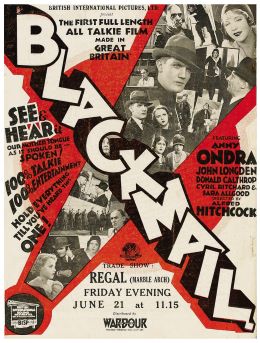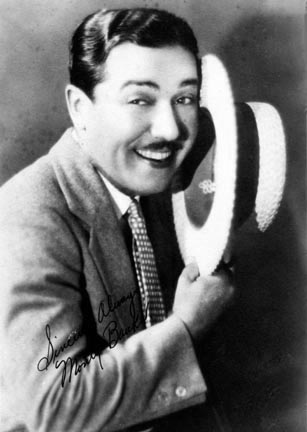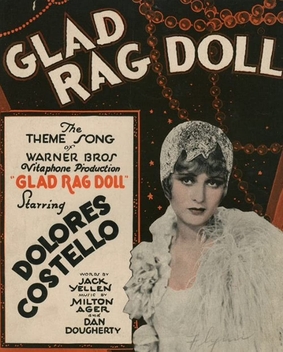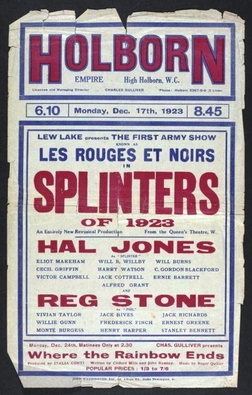A splinter is a sharp fragment of material, usually wood, metal, or fibreglass.

A revue is a type of multi-act popular theatrical entertainment that combines music, dance, and sketches. The revue has its roots in 19th century popular entertainment and melodrama but grew into a substantial cultural presence of its own during its golden years from 1916 to 1932. Though most famous for their visual spectacle, revues frequently satirized contemporary figures, news or literature. Similar to the related subforms of operetta and musical theatre, the revue art form brings together music, dance and sketches to create a compelling show. In contrast to these, however, revue does not have an overarching storyline. Rather, a general theme serves as the motto for a loosely related series of acts that alternate between solo performances and dance ensembles.

Blackmail is a 1929 British thriller directed by Alfred Hitchcock and starring Anny Ondra, John Longden, and Cyril Ritchard. Based on the 1928 play of the same name by Charles Bennett, the film is about a London woman who is blackmailed after killing a man who tries to rape her.

The Singing Fool is a 1928 American sound part-talkie musical drama motion picture directed by Lloyd Bacon which was released by Warner Bros. In addition to sequences with audible dialogue or talking sequences, the film features a synchronized musical score and sound effects along with English intertitles. The soundtrack was recorded using the Vitaphone sound-on-disc system. The film stars Al Jolson and is a follow-up to his previous film, The Jazz Singer. It is credited with helping to cement the popularity of American films of both sound and the musical genre. The film entered the public domain on January 1, 2024.

Montague (Monty) Banks was a 20th century Italian-born American comedian, film actor, director and producer who achieved success in the United States and United Kingdom.
Phonofilm is an optical sound-on-film system developed by inventors Lee de Forest and Theodore Case in the early 1920s.

Song of the West is a 1930 American Pre-Code musical western film produced by Warner Bros., and photographed entirely in Technicolor. It was based on the 1928 Broadway musical Rainbow by Vincent Youmans (music), Oscar Hammerstein II (lyrics) and Laurence Stallings (book). It starred John Boles, Joe E. Brown and Vivienne Segal, and was the first all-color all-talking feature to be filmed entirely outdoors.
Merton Park Studios, opened in 1929, was a British film production studio located at Long Lodge, 269 Kingston Road in Merton Park, South London. In the 1940s, it was owned by Piprodia Entertainment, Nikhanj Films and Film Producers Guild.

Paris is a 1929 American pre-Code musical comedy film, featuring Irène Bordoni. It was filmed with Technicolor sequences: four of the film's ten reels were originally photographed in Technicolor.

Glad Rag Doll is a 1929 American sound part-talkie pre-Code drama film directed by Michael Curtiz, and starring Dolores Costello, Ralph Graves, and Audrey Ferris. In addition to sequences with audible dialogue or talking sequences, the film features a synchronized musical score and sound effects, along with English intertitles. The soundtrack was recorded using the Vitaphone sound-on-disc system. This is one of many lost films of the 1920s, no prints or Vitaphone discs survive, but the trailer survives. The film's working title was Alimony Annie, but was changed match the title of the theme song. The theme song is entitled Glad Rag Doll both played and sung throughout the soundtrack.
The Co-Optimists is an all-talking sound 1929 British musical film revue directed by Edwin Greenwood and Laddie Cliff and starring Davy Burnaby, Stanley Holloway and Betty Chester. It was made at Twickenham Studios. The film was broken up into parts and re-released as six short films in 1931.

Nine Men is a 1943 British war film, set in the Western Desert Campaign during the Second World War.

The Terror is a 1928 American pre-Code horror film written by Harvey Gates and directed by Roy Del Ruth, based on the 1927 play of the same name by Edgar Wallace. It was the second "all-talking" motion picture released by Warner Bros., following Lights of New York. It was also the first all-talking horror film, made using the Vitaphone sound-on-disc system.

My Wife's Lodger is a 1952 British comedy film directed by Maurice Elvey and starring Dominic Roche, Olive Sloane and Leslie Dwyer. The screenplay concerns a soldier who returns home after the Second World War only to find a spiv lodger has established himself in his place. It was based on the play My Wife's Lodger written by Roche.
The Clue of the New Pin is a 1929 all-talking sound British crime film directed by Arthur Maude and starring Benita Hume, Kim Peacock, and Donald Calthrop. The soundtrack was recorded using the British Phototone sound-on-disc system. It was made at Beaconsfield Studios. This film is important historically as being Britain's first all-talking feature film produced entirely in Britain. The very first all-talking British feature production, a film entitled Black Waters, had been produced in the United States due to a lack of sound recording equipment in Britain.

The Crimson Circle is a 1929 British-German sound part-talkie crime film directed by Frederic Zelnik and starring Lya Mara, Fred Louis Lerch, and Stewart Rome. In addition to sequences with audible dialogue or talking sequences, the film features a synchronized musical score and sound effects along with English intertitles. The sound was recorded via the De Forest Phonofilm sound-on-film process. The film is an adaptation of the 1922 Edgar Wallace novel The Crimson Circle in which Scotland Yard detectives battle a gang of blackmailers. A previous UK version was filmed in 1922.

The Case of Sergeant Grischa is a 1930 American pre-Code drama film directed by Herbert Brenon, based on the German novel of the same name by Arnold Zweig. John Tribby was nominated for an Academy Award for Best Sound Recording. No known copy of this film exists and is considered lost, the only sound film to have been nominated for an Oscar and subsequently suffered this fate.
Lew Lake was an English comic actor, writer, producer, and theatre manager.
Ford and Sheen were a British double act of drag artists, popular in variety shows and pantomimes between the 1930s and 1970s. They were Vic Ford and Chris Sheen.

Splinters was a popular theatrical revue that ran in several versions in Britain between the First World War and the 1930s. It featured female impersonators, and men cross-dressing as women, and was originally developed in the First Army by a concert party, Les Rouges et Noirs. A film version was made in 1929, with sequels.












